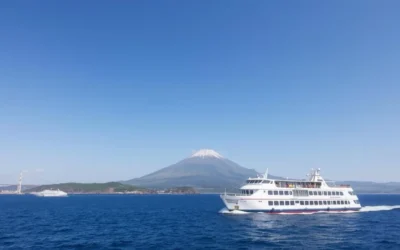✓ Accommodations✓ Flights✓ Rental Cars✓ Tours & Activities
Discover the authentic charm of Katsushika-ku, a hidden gem in eastern Tōkyō, where traditional Japanese culture thrives. This underrated district offers a unique experience that blends historical sites, cultural landmarks, and natural beauty, making it a must-visit destination.
As you explore this classical “shitamachi” (old town) area, you’ll be immersed in the rich history and atmosphere of old Japan. Visit famous temples like Shibamata Taishakuten, and enjoy the serene riverside experiences that showcase the best of this Tokyo ward.
With its unique blend of old and new, Katsushika-ku is an ideal spot to experience the authentic side of Tōkyō. Get ready to uncover the top attractions and insider tips that make this district special.
Discovering Katsushika-ku: Tokyo’s Hidden Gem
Tucked away in the eastern part of Tokyo, Katsushika-ku is a treasure trove of traditional Japanese culture waiting to be explored. This district offers a unique opportunity to step back in time and experience the authentic Japan.
Location and Overview
Katsushika City, situated in the eastern part of Tokyo, is a beloved and enjoyed classical “shitamachi” (old town) district. It retains its old, traditional Japanese flavor and atmosphere, making it a unique spot in the modernized Tokyo landscape.
Katsushika-ku is characterized by its historical temples, such as Shibamata Taishakuten and the Approach to Taishakuten Temple, alongside several popular tourist attractions. The district is also famously known as the setting for the manga comic “Kochira Katsushika-ku Kameari Koen-mae Hashutujo,” set in Kameari.

The Rich History of Katsushika
The history of Katsushika is deeply rooted in traditional Japan. This district has managed to preserve its cultural heritage, offering visitors a glimpse into the past. The historical significance of Katsushika is evident in its temples, traditional architecture, and the overall culture that permeates the area.
As you explore Katsushika, you’ll discover that it’s not just a place to visit but an experience that immerses you in the traditional Japanese way of life. The district’s ability to maintain its historical essence amidst modern Tokyo makes it a fascinating destination.
Why Visit This Authentic Shitamachi District
Visiting Katsushika offers numerous benefits, including:
- An authentic “shitamachi” experience that’s rare in modernized Tokyo.
- A more relaxed pace of life, with strong local traditions and community spirit.
- A living museum of everyday Japanese life, showcasing genuine local culture.
- Excellent value for travelers, with lower prices for accommodations, food, and shopping.
- Insights into the real Tokyo that most international visitors never see.
By visiting Katsushika, you’ll gain a more nuanced understanding of Tokyo’s diverse cultural landscape, making your Japan experience more complete and meaningful.
Shibamata: Walking in Tora-san’s Footsteps
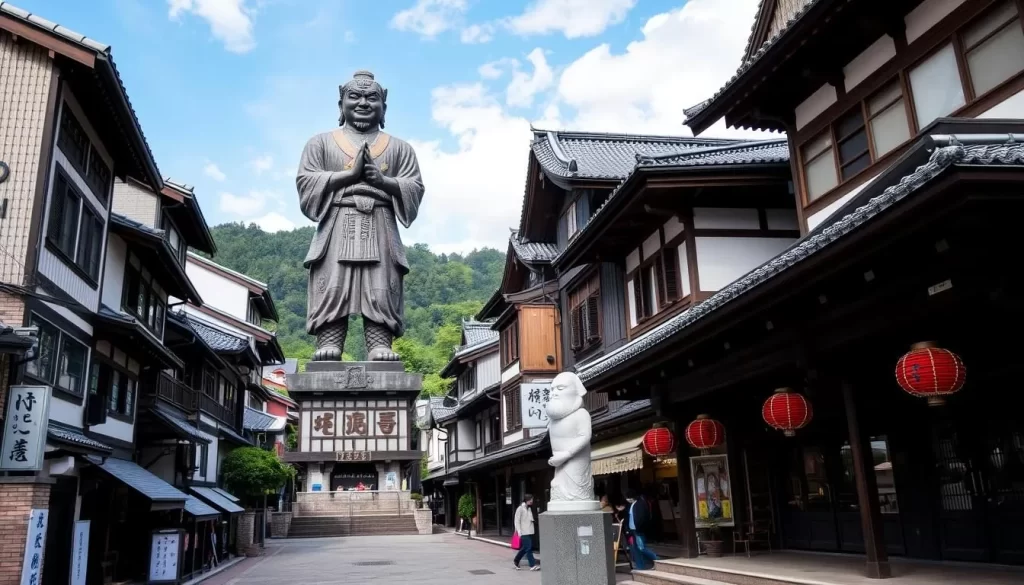
Step into Shibamata, and you’ll discover a nostalgic Tokyo that blends traditional culture with modern charm. This historic district is famous for its connection to the beloved Japanese film series “Otoko wa Tsurai yo” (It’s Tough Being a Man), starring Kiyoshi Atsumi as the lovable Tora-san. Visitors can walk in Tora-san’s footsteps and experience the traditional Japanese atmosphere that has been preserved over the years.
Shibamata Taishakuten Temple
At the heart of Shibamata lies the revered Shibamata Taishakuten Temple, a significant cultural and spiritual landmark. This temple, dedicated to the deity Taishakuten (the Buddhist version of the Hindu god Indra), is a place of solace and worship for locals and visitors alike. The temple’s serene atmosphere, coupled with its historical significance, makes it a must-visit destination.
The temple complex is not just a religious site but also a cultural hub, offering insights into traditional Japanese practices and ceremonies. Visitors can explore the temple grounds, participate in or observe religious rituals, and enjoy the peaceful surroundings.
The Historic Approach to Taishakuten
The path leading to Shibamata Taishakuten is a historic shopping street that embodies the spirit of old Japan. Lined with traditional shops selling local crafts, regional delicacies, and souvenirs, this street is an experience in itself. Visitors can stroll along the street, taking in the sights, sounds, and aromas of traditional Japan.
The street is particularly famous for its traditional snacks, such as “kusa mochi” (yomogi rice cakes) and “dango” (sweet rice dumplings), which are made using time-honored recipes. The authentic atmosphere is maintained by shopkeepers who continue to use traditional methods to create their products.
Exploring the Shopping Street
The shopping street in front of the station is not to be missed. It offers a delightful array of traditional shops selling everything from local crafts to regional delicacies. You’ll want to try the area’s famous “food” items like “kusa mochi” and “dango” from shops that have been perfecting these recipes for generations.
- The vibrant shopping street leading to Shibamata Taishakuten offers a delightful array of traditional shops.
- You’ll want to try the area’s famous “kusa mochi” and “dango” from shops that have been perfecting these recipes for generations.
- The street maintains an authentic atmosphere with many shopkeepers wearing traditional clothing.
- Take your time to explore the numerous specialty stores selling items like hand-crafted chopsticks and local sake.
- The shopping experience here differs dramatically from Tokyo’s modern commercial districts.
As you explore the shopping street, you’ll discover the rich cultural heritage of Shibamata, making for a memorable visit.
The Tora-san Museum: Celebrating a Japanese Icon

Step into the world of Japan’s beloved film icon, Tora-san, at the dedicated museum in Shibamata. The Tora-san Museum is a treasure trove for fans of the ‘Otoko wa Tsuraiyo’ series, offering a unique glimpse into the life and times of this iconic character.
The World of “Otoko wa Tsuraiyo”
The ‘Otoko wa Tsuraiyo’ series, which translates to “It’s Tough Being a Man,” follows the adventures of Torajirō Kuruma, affectionately known as Tora-san. This long-running film series captured the hearts of audiences with its blend of comedy, drama, and heartwarming stories. At the Tora-san Museum, you can delve into the world of Tora-san through various exhibits showcasing memorabilia, costumes, and behind-the-scenes insights into the making of the films.
The museum is designed to recreate the nostalgic atmosphere of the Shōwa period, a time when the films were set. As you explore the museum, you’ll be surrounded by the charm of old Japan, with artifacts and displays that bring the Tora-san stories to life.
Exhibits and Highlights
The Tora-san Museum is home to a wide range of exhibits that celebrate the series. You’ll find displays of Tora-san’s iconic travel souvenirs, his beloved family, and the various characters that populated his adventures. One of the highlights is the recreation of scenes from the films, allowing visitors to step into the world of ‘Otoko wa Tsuraiyo.’
Notable Exhibits: Tora-san’s travel souvenirs, character figurines, and memorabilia from the film series.
The museum also hosts temporary exhibitions, so there’s always something new to discover during your visit.
Rooftop Views of Shibamata
One of the unique features of the Tora-san Museum is its rooftop, Shibamata Park, which offers panoramic views of the surrounding area. From here, you can see the iconic Shibamata Taishakuten Temple and the serene flow of the Edo River. This vantage point provides a fascinating perspective on the geographical layout of Shibamata and how it was used as a backdrop in the Tora-san films.
The rooftop park is particularly beautiful during cherry blossom season or autumn, making it a great spot for photography.
Yagiri no Watashi: Tokyo’s Last Traditional Ferry
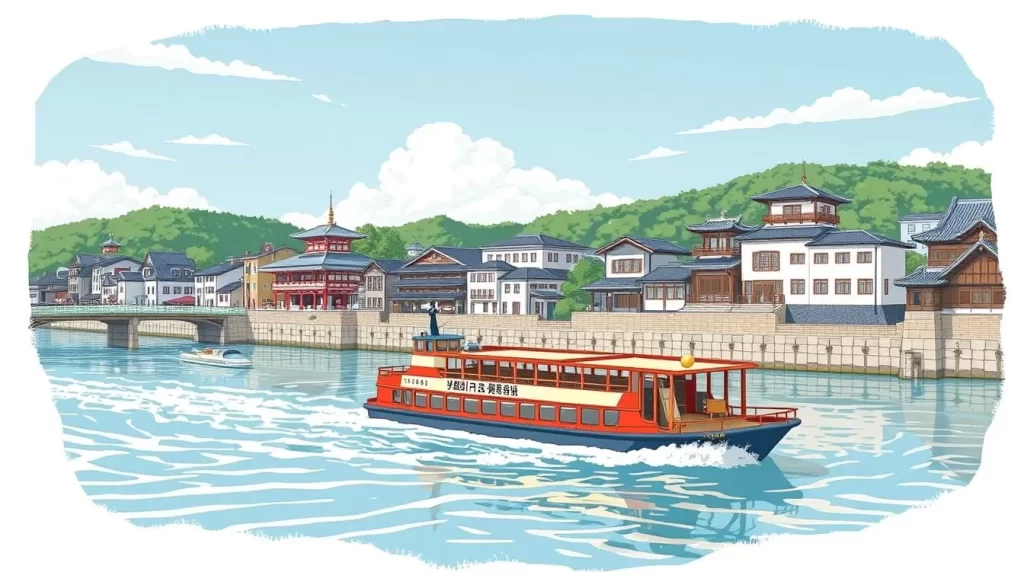
Step aboard Yagiri no Watashi, Tokyo’s last remaining traditional ferry, for a tranquil journey across the Edo River. This historic ferry service has been in operation for centuries, offering a unique glimpse into Tokyo’s past.
History of the Edo River Crossing
The Yagiri no Watashi ferry has a rich history dating back to the Edo period. It was an essential transportation link between the cities of Tokyo and Chiba, facilitating trade and travel across the Edo River. Over the years, the ferry has witnessed the transformation of Tokyo from a small fishing village to a bustling metropolis.
Despite the advent of modern transportation, Yagiri no Watashi has managed to retain its traditional charm. The ferry continues to operate, providing a nostalgic experience for locals and tourists alike.
The Ferry Experience Today
Today, Yagiri no Watashi offers a serene escape from the city’s hustle and bustle. As you cross the Edo River, you can enjoy the picturesque views of the surrounding landscape. The ferry operates daily during the summer months and on weekends and holidays during the winter.
This traditional ferry experience is a must-visit spot for anyone looking to explore Tokyo’s hidden gems. You can enjoy a peaceful experience on the ferry, taking in the sights and sounds of the river.
Best Times to Visit
The best times to visit Yagiri no Watashi depend on your preferences. Here are a few options:
- The ferry operates daily during summer months (typically April through November), giving you more flexibility when planning your visit during the warmer seasons.
- Winter operations are limited to weekends and holidays only, so you’ll need to plan accordingly if visiting between December and March.
- Early morning crossings offer the most peaceful experience and the best lighting for photography, with fewer visitors and beautiful morning light on the water.
- Cherry blossom season (late March to early April) provides a magical backdrop for your ferry crossing, with pink blossoms framing the river views.
- Sunset crossings create a romantic atmosphere as the golden light reflects off the water, making this humble transportation method one of Tokyo’s most picturesque spots.
Kameari: Home of the Famous Manga “Kochira Katsushika-ku”
Kameari, a hidden gem in Tokyo’s Katsushika-ku, offers a unique blend of traditional and modern attractions, thanks in part to its fame as the setting for ‘Kochira Katsushika-ku Kameari Koen-mae Hashutsujo’.
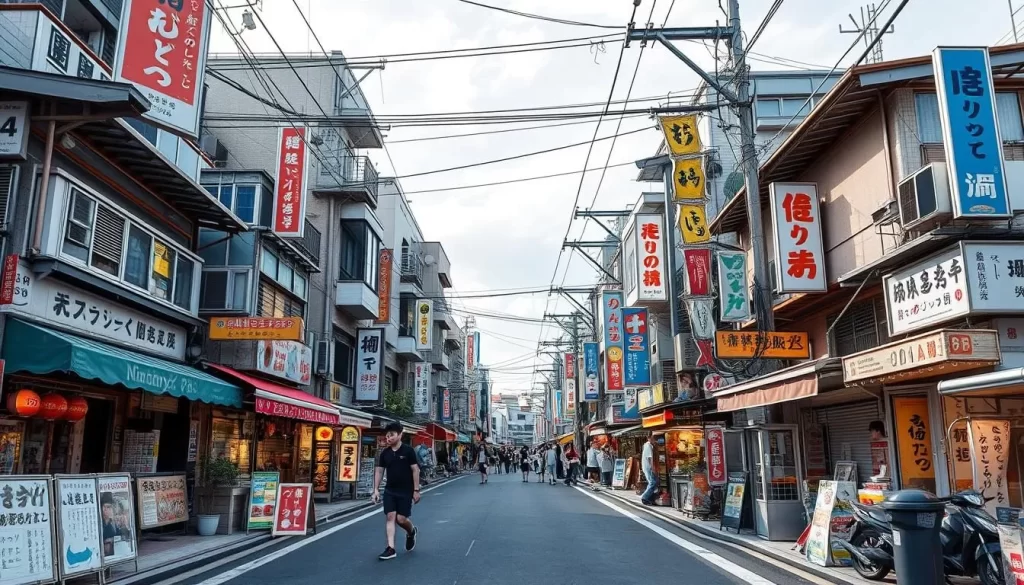
Kameari Park and the Ryotsu Statues
Kameari Park is a must-visit attraction, especially for fans of the manga. The park features statues of the main character, Ryotsu Kankichi, adding a touch of nostalgia and charm to the area.
The statues are a popular spot for photos, and the park itself is a serene escape from the hustle and bustle of city life. Visitors can enjoy a leisurely stroll around the park, taking in the sights and sounds of nature.
Kameari Food Market
The retro Kameari food market, located near the south exit, is a treasure trove of local flavors and traditional cuisine. Visitors can sample a variety of dishes, from street food to local specialties, making it a great place to experience the authentic taste of Kameari.
The market’s nostalgic atmosphere adds to its charm, making it a memorable part of any visit to the area.
Ario Kameari Shopping Complex
Ario Kameari represents the modern face of Katsushika-ku Kameari, offering a contemporary shopping experience alongside the area’s more traditional attractions. You’ll find a comprehensive selection of shops, from major Japanese retail chains to specialty boutiques, making it convenient to pick up anything you might need during your visit.
The complex also houses an excellent food court and numerous restaurants that serve both Japanese and international cuisine, providing comfortable dining options after exploring the neighborhood. Ario Kameari frequently hosts special events and exhibitions related to the famous manga, creating a bridge between modern retail and local cultural heritage.
Natural Retreats in Katsushika-ku
Katsushika-ku is a hidden gem in Tokyo, offering a variety of natural retreats that provide a serene escape from the city’s hustle and bustle. As you explore this charming ward, you’ll discover numerous parks and gardens that showcase the beauty of nature in the heart of the city.
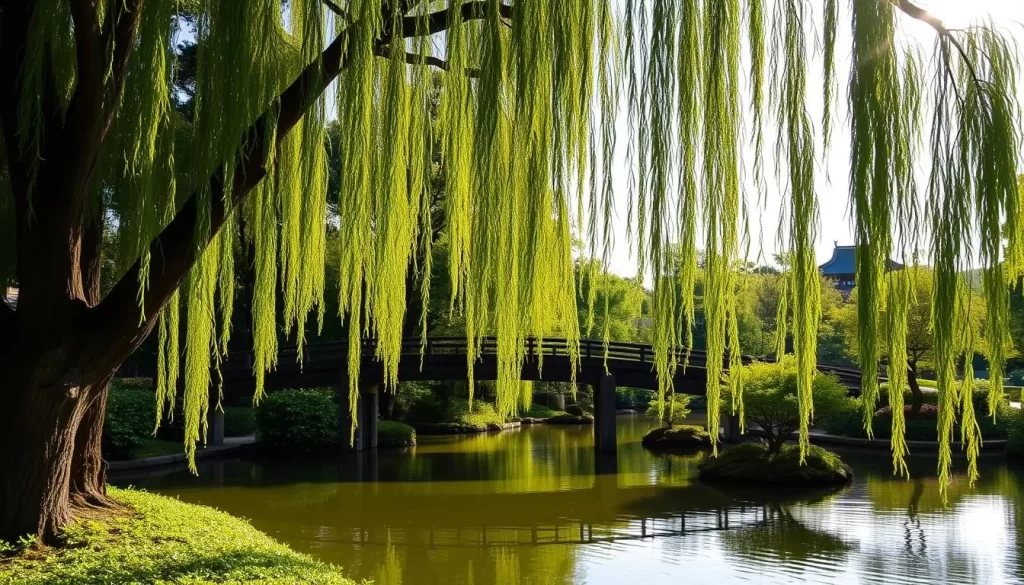
Mizumoto Park: Tokyo’s Largest Waterfront Park
Mizumoto Park stands out as Tokyo’s largest waterfront park, offering a tranquil atmosphere amidst the urban landscape. As you stroll through the park, you’ll be greeted by the beautiful scenery of cherry blossoms in the spring. In fact, when the Someiyoshino cherry trees are in full bloom, they create a breathtaking scene that is truly unforgettable. The park’s cherry tree-lined waterways are especially photogenic during late March to early April, making it a perfect spot for nature lovers and photographers alike.
During the summer, Mizumoto Park transforms with the blooming of vibrant water lilies and lotus flowers in its ponds. The park’s extensive flower beds continue to showcase seasonal blooms throughout the year, ensuring that there’s always something new to discover. Whether you’re looking for a peaceful walk or a picturesque spot for a picnic, Mizumoto Park is an ideal destination.
Horikiri Iris Garden
For a splash of color and a touch of history, visit the Horikiri Iris Garden. This beautiful garden is particularly stunning in early summer when thousands of irises reach their peak bloom, typically in June. The vibrant purple flowers create a breathtaking landscape that continues a flower-viewing tradition dating back centuries. As you walk through the garden, you’ll be surrounded by the serene beauty of nature, making it a perfect retreat from the city’s bustle.
The Horikiri Iris Garden is not just a summer delight; it also offers beautiful plum blossoms in February, making it a great spot for year-round visits. Whether you’re a fan of irises or simply looking for a peaceful escape, this iris garden is a must-visit destination in Katsushika-ku.
Seasonal Flower Viewing Opportunities
Katsushika-ku offers you year-round flower viewing opportunities, making it a nature lover’s paradise. Beginning with plum blossoms in February at several gardens, including the Horikiri Iris Garden, each season brings its unique floral displays. Spring brings spectacular cherry blossom displays throughout the ward, while autumn offers golden ginkgo trees and red maples throughout Katsushika’s parks and temple grounds.
As you explore Katsushika-ku, you’ll find that each season provides a colorful backdrop for your adventures. From the vibrant blooms of spring and summer to the autumn foliage, the ward’s natural beauty is a constant source of delight. So, whether you’re a local or just visiting, Katsushika-ku’s natural retreats are sure to leave you with lasting memories.
Katsushika-ku, Tōkyō, Japan: Best Things to Do – Top Picks
Katsushika-ku is a treasure trove of unique experiences, from film and manga to nature and entertainment. This district in Tokyo offers a wide range of activities that cater to different interests and age groups, making it an ideal destination for various types of travelers.
Cultural Landmarks Not to Miss
Katsushika-ku is home to several cultural landmarks that are worth visiting. The Tora-san Memorial Museum is a must-visit for film enthusiasts, as it recreates and exhibits the world of the movie “Otoko wa Tsuraiyo” and other related materials. You can enjoy an immersive film experience with interactive exhibits that showcase the history of Japanese cinema.
The museum offers a unique glimpse into the world of Japanese film, with engaging displays that appeal to visitors of all ages. Additionally, you can follow the “Kochira Katsushika-ku” manga trail, which features character statues and landmarks from the famous police comedy series, providing a fun and uniquely Japanese pop culture experience.
Outdoor Activities for Nature Lovers
Nature lovers will find plenty to enjoy in Katsushika-ku. The ward boasts several parks and gardens that offer a serene escape from the hustle and bustle of city life. Mizumoto Park, Tokyo’s largest waterfront park, is a great place to relax and enjoy outdoor activities. You can take a leisurely stroll, have a picnic, or simply enjoy the scenic views.
The Horikiri Iris Garden is another beautiful spot, especially during the iris blooming season. The garden features a variety of iris flowers, creating a picturesque landscape that is perfect for photography. Seasonal flower viewing opportunities are also available in other parks, making Katsushika-ku a great destination for nature enthusiasts.
Entertainment Options for All Ages
Katsushika-ku offers a range of entertainment options that cater to all ages. Families with children will appreciate the numerous well-maintained playgrounds throughout the ward, including the extensive facilities at Kameari Park. The ward also hosts seasonal festivals and events, such as the spectacular Katsushika Noryo Fireworks Festival in summer, which lights up the night sky.
For shopping and dining, you can explore traditional markets or visit modern malls like Ario Kameari, ensuring that there’s something for everyone regardless of weather or preferences. Whether you’re looking for traditional Japanese cuisine or modern entertainment, Katsushika-ku has it all.
Traditional Japanese Experiences in Katsushika
Visitors to Katsushika-ku can enjoy a range of authentic Japanese experiences, from relaxing in natural hot springs to participating in traditional tea ceremonies. This blend of traditional activities offers a unique glimpse into Japan’s rich cultural heritage.
Tokyo Tenneno Onsen Kodai Hot Spring
A visit to Tokyo Tenneno Onsen Kodai Hot Spring is a must for those seeking relaxation. This hot spring facility offers a serene atmosphere, perfect for unwinding. The spring’s natural hot water is believed to have healing properties, making it an ideal experience for both locals and tourists.
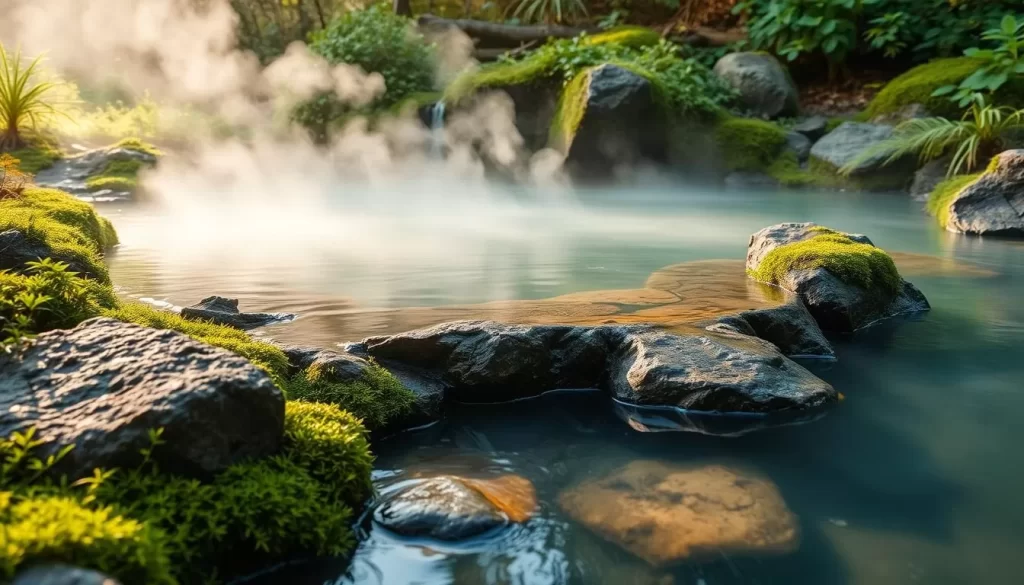
Traditional Crafts and Workshops
Katsushika-ku is home to various traditional crafts and workshops where you can learn about local artisans’ skills. These workshops provide a hands-on experience, allowing participants to create their own traditional crafts under expert guidance.
The opportunity to engage in traditional crafts not only preserves cultural heritage but also offers a unique insight into the local way of life.
Authentic Tea Houses and Gardens
The district boasts several traditional Japanese gardens, such as the Horikiri Iris Garden, which features authentic tea houses. At these tea houses, you can experience the ceremonial preparation and drinking of matcha green tea in a serene atmosphere. The gardens are meticulously maintained, offering a tranquil garden setting that changes with the seasons.
The “Seikan-tei” restaurant within the Horikiri Iris Garden serves seasonal Japanese cuisine and offers a refined setting for enjoying local delicacies while overlooking the beautifully maintained garden.
Tateishi: The Ultimate Local Drinking Experience

For a truly local drinking experience, Tateishi in Tokyo is unbeatable. This vibrant district is known for its unique drinking culture, where visitors can enjoy a wide range of local foods and drinks in a lively atmosphere.
The Famous Daytime Sake Culture
Tateishi is renowned for its daytime sake culture, a trait that sets it apart from other drinking districts. Here, you can enjoy a cold sake or beer during the day, accompanied by delicious local dishes.
The culture is deeply rooted in the area’s history and working-class heritage, making it a fascinating experience for visitors.
Best Izakayas and Bars
Tateishi is home to numerous izakayas and bars, each offering a unique experience. Many of these establishments specialize in yakitori, with expertly grilled chicken skewers prepared right before your eyes.
Some standout bars are known for their extensive sake selections, while others offer a cozy atmosphere perfect for a casual drink.
Food Specialties to Try
While enjoying your drinks in Tateishi, be sure to try some of the local specialties. “Motsuni,” a hearty stew made with beef or pork offal, is a must-try, complementing cold beer or sake perfectly.
Other dishes to look out for include “oden,” a comforting winter dish simmered in dashi broth, and “nikomi,” slow-cooked stews that pair well with the local drinking culture. For a quick snack, “takoyaki” from street vendors is a popular choice.
Your drinking experience in Tateishi will be enhanced by the variety of food available, ensuring a memorable visit.
Seasonal Events and Festivals in Katsushika
As the seasons change, Katsushika comes alive with various festivals and events that highlight the ward’s unique charm. From summer fireworks to winter illuminations, there’s always something to look forward to in this vibrant Tokyo ward.
Katsushika Noryo Fireworks Festival
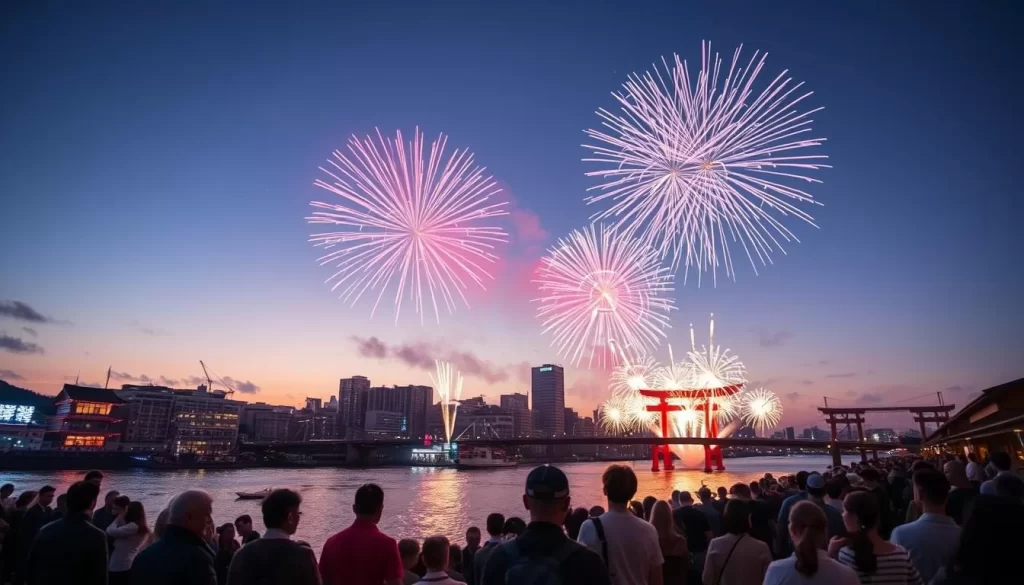
The Katsushika Noryo Fireworks Festival is one of the most anticipated summer events in the ward, attracting visitors from all over Tokyo. The festival features a stunning fireworks display over the Edo River, creating a breathtaking night spectacle.
The event is a perfect opportunity to experience the local culture and enjoy the festive atmosphere. With food stalls and games available, it’s a fun day out for the whole family.
Cherry Blossom Viewing Spots
Katsushika is also a great place to enjoy cherry blossoms during the spring season. Mizumoto Park is one of the ward’s most popular cherry blossom viewing spots, with its beautiful trees lining the park’s pathways.
Visitors can enjoy a leisurely stroll under the blooming cherry blossoms, taking in the serene atmosphere of the park.
Winter Illuminations and New Year Celebrations
Winter transforms Katsushika with magical illumination events, particularly at Mizumoto Park where thousands of LED lights create a fantasy landscape during December and January nights.
You can experience traditional Japanese New Year celebrations at local temples, with Shibamata Taishakuten hosting one of the area’s most significant hatsumode (first shrine visit of the year) events. The temple grounds are beautifully illuminated, creating a peaceful and festive atmosphere.
Off the Beaten Path: Hidden Gems in Katsushika
For those willing to venture off the beaten path, Katsushika-ku reveals its authentic charm. This district is filled with lesser-known temples, vibrant local markets, and unique spots perfect for capturing memorable photos.
Lesser-Known Temples and Shrines
Katsushika-ku is home to several temples and shrines that are off the typical tourist radar. While many visitors flock to the more famous sites, these hidden gems offer a tranquil and authentic experience. You can explore the serene grounds and historic significance of these lesser-known sites, providing a deeper understanding of the local culture.
Local Markets and Shopping Streets
The district boasts a variety of local markets and shopping streets that showcase its community spirit and traditional commerce. You can stroll along the historic shopping street approaching Shibamata Taishakuten, where traditional architecture and nostalgic atmosphere create a captivating experience. Additionally, Kameari’s food market offers a taste of local cuisine and culture, making it a great place to explore.
Here is a summary of some local markets and shopping streets you might enjoy:
| Location | Main Attraction | Best Time to Visit |
|---|---|---|
| Shibamata | Historic shopping street | Anytime |
| Kameari | Food market | Morning to early afternoon |
| Tateishi | Daytime sake culture | Late afternoon to evening |
Unique Photo Spots for Social Media
Katsushika-ku offers numerous unique photo opportunities that are perfect for social media. You can capture the “Kochira Katsushika-ku” manga character statues throughout Kameari, with the “Double Peace” Ryotsu pose being particularly popular. The Yagiri no Watashi ferry provides a unique perspective of Tokyo against the backdrop of the Edo River. Additionally, the Horikiri Iris Garden is stunning during the June iris bloom, creating a sea of purple flowers. Don’t forget to look out for whimsical street art and character decorations scattered throughout the neighborhoods.
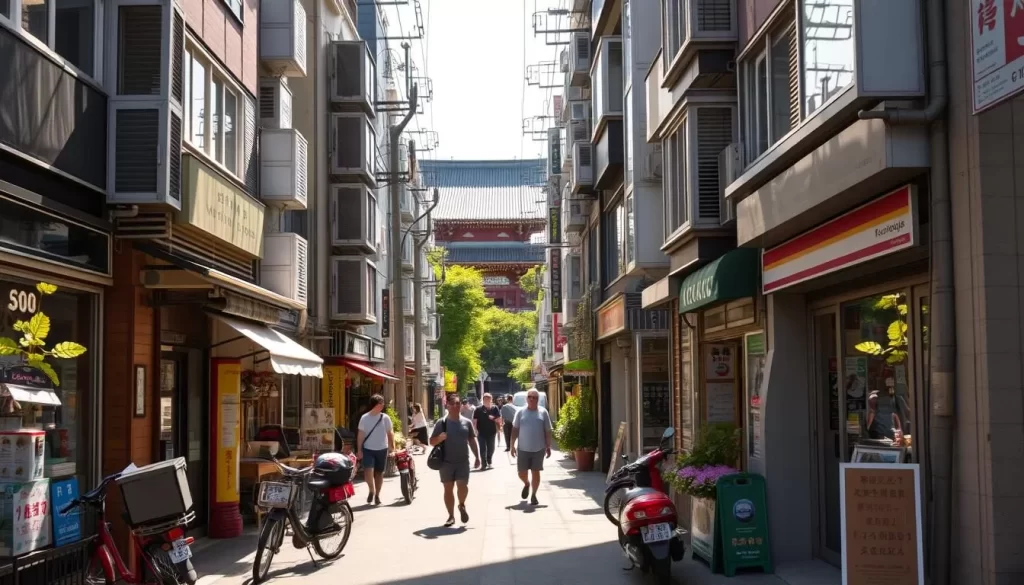
As you explore Katsushika-ku, you’ll discover that each area has its own character and charm, from the traditional to the modern. Whether you’re looking for a unique spot to capture on camera or simply want to experience the local way of life, Katsushika-ku has something to offer.
Where to Stay in Katsushika-ku
For travelers heading to Katsushika-ku, selecting the right area to stay can significantly enhance their exploration of this unique Tokyo district. Katsushika ward, with its rich history, cultural landmarks, and natural retreats, offers a variety of experiences that can be fully appreciated with the right accommodation choice.
Light Hotel and Other Accommodations
Katsushika-ku offers a range of accommodations to suit different preferences and budgets. The Light Hotel is one of the notable options, providing comfortable stays with convenient access to local attractions. When searching for hotels in Katsushika, Tokyo, consider the location and the amenities offered to ensure they meet your travel needs.
Other accommodations in the area range from budget-friendly options to more luxurious stays, each offering a unique experience. Whether you’re looking for a place to rest after exploring Shibamata or a comfortable base to enjoy the local cuisine in Tateishi, Katsushika-ku has something for everyone.
Neighborhood Guide for First-Time Visitors
For first-time visitors to Katsushika ward, the Shibamata area is highly recommended due to its excellent transportation connections and proximity to major attractions like Taishakuten Temple. The Kameari neighborhood is another great option, offering a balance of local atmosphere and convenient amenities, including manga-related attractions and shopping centers.
If you’re more interested in exploring the natural side of Katsushika, consider staying near Kanamachi Station, which provides good bus connections to Mizumoto Park. For a more immersive local experience, the Tateishi area is known for its retro atmosphere and excellent food and drink options, though accommodations are more limited.
Regardless of which neighborhood you choose, Katsushika’s excellent public transportation system makes it easy to explore the entire ward and connect to central Tokyo city attractions, ensuring that you’re always just a short journey away from the next great experience.
Dining Guide: Must-Try Foods in Katsushika
From traditional sweets to savory street food, Katsushika offers a unique dining experience that showcases the best of Japanese cuisine. As you explore this charming district, you’ll discover a diverse range of local specialties and traditional dishes that are sure to delight your taste buds.
Local Specialties and Traditional Dishes
Katsushika is renowned for its traditional Japanese sweets, particularly those found along the approach to Shibamata Taishakuten. You can sample “kusa-mochi” (yomogi rice cakes) that have been made using the same recipes for generations. These sweet treats are a perfect representation of the district’s rich culinary heritage.
Another must-try is “taiyaki,” fish-shaped cakes filled with sweet red bean paste, available from street vendors near Kameari Station. The combination of a crisp outer shell and a perfectly sweet filling makes for an ideal snack. Be sure to try these local specialties to experience the authentic flavors of Katsushika.
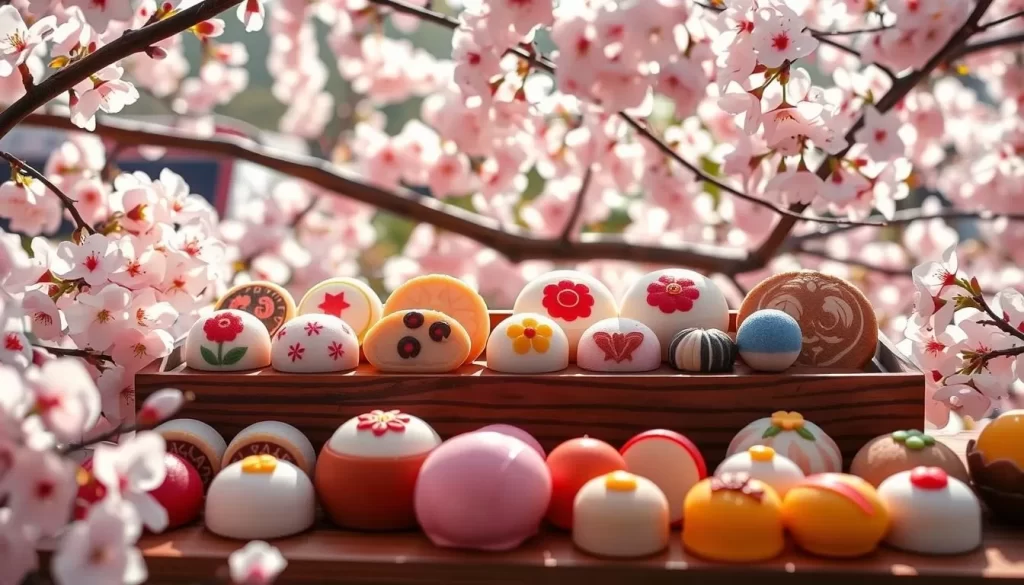
Best Restaurants and Food Stalls
Katsushika is home to a variety of excellent restaurants and food stalls serving traditional Japanese cuisine. You can find everything from classic dishes to modern fusion cuisine. When visiting Kameari, be sure to stop by the local food market, where you can sample a range of delicious foods.
For a unique dining experience, head to the street vendors near Kameari Station, where you can try “taiyaki” and other local specialties. The district is also known for its old-fashioned ice cream shops, which serve unique flavors like purple sweet potato and black sesame.
Sweet Treats and Desserts
Katsushika is a paradise for those with a sweet tooth. In addition to traditional Japanese sweets like “kusa-mochi” and “taiyaki,” you can also try seasonal wagashi (Japanese confectionery) that reflect the changing natural world. From cherry blossoms in spring to autumn leaves in fall, the designs and flavors of wagashi are a perfect representation of the district’s natural beauty.
Don’t miss trying freshly made “senbei” (rice crackers) from specialty shops, where you can watch the crackers being grilled right before your eyes. You can also enjoy unique ice cream flavors at one of the many old-fashioned ice cream shops throughout Katsushika.
Practical Information for Visitors
To ensure a smooth and enjoyable experience in Katsushika, it’s essential to be prepared with some key information. Whether you’re a seasoned traveler or just starting to plan your trip, understanding the basics of getting around, the best times to visit, and how to save money can make a significant difference in your travel experience.
Getting to and Around Katsushika
Katsushika is conveniently connected to central Tokyo through various public transportation options. You can easily reach Katsushika by train or bus, with multiple lines available, including the JR Sobu Line and the Keisei Line. To navigate the area, consider purchasing a prepaid IC card like Suica or Pasmo, which can be used across different train and bus lines, making your travel experience seamless. If you’re planning to use public transportation frequently, it might be worth calculating whether a 1-day or 3-day Tokyo subway pass would be economical for your itinerary.
| Transportation Option | Details | Convenience Level |
|---|---|---|
| JR Sobu Line | Direct access to central Tokyo | High |
| Keisei Line | Connection to Narita Airport | Medium |
| Prepaid IC Card (Suica/Pasmo) | Reusable card for multiple lines | High |
Best Times to Visit
The best time to visit Katsushika is during the spring (March to May) and autumn (September to November), when the weather is mild and comfortable, making it ideal for outdoor activities and sightseeing. Avoid visiting during the peak summer months if you’re sensitive to heat and humidity, or during the New Year (January 1st) when some local businesses may be closed.
Money-Saving Tips
To make the most of your travel budget, consider a few money-saving strategies. Take advantage of combination tickets offered at some attractions, such as the joint ticket for the Tora-san Museum and Yamada Yoji Museum. Staying in Katsushika rather than central Tokyo can also save you around 30-40% on accommodation costs. Additionally, eating at local family-run restaurants throughout Katsushika offers excellent value compared to tourist-oriented establishments. Many of Katsushika’s best experiences are free or low-cost, including walking historic shopping streets and enjoying the seasonal beauty of public parks.
- Use combination tickets for attractions to save money.
- Consider staying in Katsushika for lower accommodation costs.
- Eat where local people eat for better value.
- Explore free or low-cost experiences like historic shopping streets and public parks.
Day Trip Itineraries from Katsushika
Day trips from Katsushika-ku provide an excellent opportunity to experience the rich cultural heritage and natural beauty of Tokyo. With several transportation options available, you can easily explore nearby attractions and enjoy a variety of activities.
One-Day Perfect Itinerary
For a fulfilling one-day trip, consider starting at Kameari Park, where you can enjoy the playground facilities and admire the manga character statues. Afterwards, head to the Ario Kameari shopping complex for lunch, where you’ll find a diverse range of Japanese and international cuisine. In the afternoon, take a bus to Mizumoto Park, Tokyo’s largest waterfront park, where you can enjoy the open spaces, rent boats, and use the barbecue facilities if you’ve made a reservation. Don’t forget to include a ride on the Yagiri no Watashi ferry, a unique travel experience that offers a glimpse into traditional Tokyo.
Weekend Exploration Plan
If you have a weekend to spare, you can explore more of what Katsushika and its surroundings have to offer. Start your weekend with a visit to the Shibamata Taishakuten Temple, followed by a stroll along the historic shopping street. On the second day, venture to the Horikiri Iris Garden, especially beautiful during the iris blooming season. You can also plan a visit to the Tora-san Museum to learn more about this beloved Japanese icon. This leisurely pace allows you to soak in the local culture and enjoy the experience without feeling rushed.
Family-Friendly Route
For a family-friendly day trip, begin at Kameari Park, which is equipped with playground facilities that kids will love, and features manga character statues that appeal to all ages. After enjoying the park, head to Ario Kameari for lunch, where the food court offers a variety of options. In the afternoon, take a bus to Mizumoto Park, where families can enjoy the open spaces and various activities, including boat rentals and barbecue facilities. A ride on the Yagiri no Watashi ferry adds an exciting element to your trip, making for a memorable experience. Visiting during a festival period can also enhance your trip with child-friendly activities and food stalls.
By incorporating these itineraries into your travel plans, you can ensure a fun and memorable trip to Katsushika-ku and its surrounding areas.
Conclusion: Why Katsushika Deserves a Spot on Your Tokyo Itinerary
Katsushika Ward, with its rich history and vibrant culture, is an authentic slice of Tokyo life waiting to be discovered. Located in the northeastern part of Tokyo, this unique area is known for its old-fashioned charm and strong community spirit.
The ward boasts historical sites such as the Shibamata Taishakuten Temple, a beloved cultural landmark from the Edo period, and the Tora-san Museum, dedicated to the famous film character Torajiro Kuruma. These attractions offer a glimpse into Japan’s cultural heritage and the beloved film series by Yamada Yoji about the tough man with a heart of gold.
Katsushika is also home to beautiful parks like Mizumoto Park, one of Tokyo’s largest waterfront parks, where you can enjoy cherry blossoms in spring and irises in summer. The lively shopping streets near Keisei Tateishi Station and traditional festivals, such as the Katsushika Noryo Fireworks Festival, provide a unique experience of local life.
One of the key advantages of visiting Katsushika Ward is its ability to offer an authentic atmosphere that is often missing in more touristy areas of Tokyo. The ward provides excellent value for travelers, with lower accommodation costs, affordable dining options, and many free or low-cost attractions, making it a budget-friendly destination without sacrificing quality experience.
By including Katsushika in your travel plans, you’ll gain a more complete understanding of Tokyo’s diversity and depth, seeing aspects of Japanese life and culture that remain hidden to those who only visit the well-known central districts. The unique neighborhoods of Katsushika offer a more relaxed pace than central Tokyo, allowing you to explore without the crowds and pressure often felt in major tourist areas.
In conclusion, Katsushika Ward is a hidden gem that deserves a spot on your Tokyo itinerary. With its rich history, cultural landmarks like the temple, and vibrant community spirit, Katsushika provides a unique and enriching experience that complements the traditional Tokyo travel itinerary.
The above is subject to change.
Check back often to TRAVEL.COM for the latest travel tips and deals.

